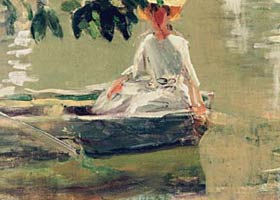
Click
HERE to see larger pictures
With the infra-red light we are able to see through
the upper layer of paint and see what is lying beneath.
You
can
see the shape of the
boat in its first position. Moreover,
we have the
black zigzag-shadow in
the water - which we recently
studied just
like those we find in several
other
works, e.g. in the
pochade: ‘La
Grenoullière’
in the Metropolitan Museum. Here we see a similar mirroring in the
water, from the boat to the far right, (in red – from the red
gunwale).

La
Grenoullière detail
|

Click
HERE for closeup and comparison. |
At the National
Gallery, London, we have the other of the two similar paintings:
‘Bathers at La Grenouillère’.
Here we can
easily see how Monet changed the positions of the boats. In the book
‘Art in the making – Impressionism’, Exhibition Catalogue, London
1990-1991, it is like music to read this: “Similarly, Monet did not
arrive at the apparently instantaneous image of Bathers at La
Grenouillère without significant revisions. Dried brush-strokes
under the present surface and the evidence of the X-ray, show that
he not only altered the arrangement of his composition, but probably
also made a first rapid lay-in of boats with the canvas the other
way up.

Click for Detail: altered positions of the
boats
This seems to
have been a false start and Monet soon turned his picture over to
begin again, but even in this painting, the outlines of the boats
were shifted several times as he worked. Perhaps he was responding
to real alterations in the scene before him, as the boats were moved
around. The red painted gunwales of boats in various different
positions can be seen quite clearly below the present surface.
(p.122-123). (For many exciting
macro-photos, X-rays, etc, try to find this book:
ISBN 0-300-05035-6).
Let’s have another look at the Infra-red photo.
Besides the zigzag-reflection in the water there ought to be another
reflection from the side of the boat. We know that the light was
coming from the setting sun, shining from the upper right corner. It
is a bit difficult to see – but it certainly is there – a smooth
water reflection alongside the boat.
|

Please click
HERE for a comparison. |
The waterline running in dark is much easier to see,
close to the boat as a deep shadow. A thin light heightening is also
running parallell in the dark shadow. We have seen similar strokes
in several paintings, indicating the breaking surface of the moving
water. Monet was very close with details like these and the effect
is obviuos – the boat is really lying there, floating in and on the
water.
|

Please click
HERE for some paintings with examples of
reflections and water-lines. |
Before closing this part about
reflections on the water surface, you simply have to take a look at
still another exciting detail. Look at the pole of the landing
stage. Can you see it mirrored in front in the water below? In dark
blue and greyish blue.
Click
HERE for next page